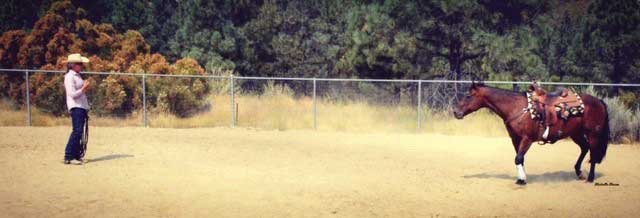By Sheryl Lynde | Horsetrader columnist

The purpose of ground work is to establish yourself as the leader in the relationship between you and your horse. Not all horses are looking for a leader, but all horses instinctively will follow a good one. It’s in their DNA.
There is order in the hierarchy of the herd. If you have studied herd behavior, you may have noticed that the dominant horse moves the horses that are below him in the direction and at the speed he chooses. You won’t see a dominant horse backing up for a horse that is subordinate to him unless he is being challenged for his role as leader of the herd. In this case, the once-dominant horse submits to the challenger, and a new leader emerges. Whoever directs the feet is in a higher position than the one being directed.
I’ve watched as some owners lead their horses. Their horse falls behind them, nudging them forward, occasionally pushing with their nose. The owner may have the lead rope in their hands, but they are being herded. Leadership belongs to their horse. When the owner stops, the horse crowds into their space. Instead of backing the horse out of their space, the owner unconsciously takes a few steps back. Backing the human is further confirmation of the horse’s dominance.
These examples may seem innocuous, but it’s the onset of disrespectful behavior in its infancy. If not corrected, it will increase in severity.
Whenever I have had a “problem” horse come to me for an issue to be resolved — like bucking, rearing or spooking — my first inquiry is about their ground work regimen. Many reply that they are consistent about their groundwork and that all is well on the ground — there is a mutual trust between them. But in the saddle, it falls apart. At this point I am suspect. Respect and trust are not mutually exclusive. Similar to human behavior, you can’t respect someone you don’t trust, and you can’t trust someone you don’t respect.
When I ask the owner to show me their ground work, more times than not the ground work is not effective. The word effective means obtaining a desired result. If the horse is fearful, then your result would be a recognizable change in his level of fear — less reactive and able to make good decisions. If the horse is disrespectful, then with each session you would see a change in his ground manners while being led, as well as an increased willingness to focus his attention on you under saddle. If the ground work is effective, you should always see a noticeable change. Some days it may be one percent, some days 75 percent, but you will always see a change.
In order to be effective, you must understand why you are doing what you are doing. If an owner tells me they do ground work regularly yet their horse lacks manners on the ground or bucks while under saddle, then the ground work has not been effective. The actions of the horse are speak so loudly that I can’t hear a word the owner is saying.
The purpose of ground work is to establish your role as leader — not aggressively, but firmly. I’m not interested in working the lungs as much as I am focused on working the horse’s mind. I do so by moving the horse’s feet in the direction I have instructed them to go. This means when I send the horse to my right, he needs to go to my right. If he tries to change direction or cut through the middle of the round pen, or turn and face me prior to being asked, I need to correct all of these diversionary tactics and continue to send the horse to my right. My cues need to be very obvious to anyone watching. If I can’t understand what the person is asking, the horse can’t either. I want to have control of all the body parts as well and am able to move them independently. If while turning to the inside he stops at an angle, I want to be able to either move his shoulder or his hip to correct his angle. I rarely allow the horse to complete a circle without asking for a transition, either a change in speed or direction. I want to direct his feet. As long as I am in the round pen or holding onto the lead rope, any bucking, rearing or other unwanted behavior will be corrected immediately.
I am the teacher, and as long as I am in the classroom, training will ensue. This is not recess or turn-out time. Be aware of your cues. Make them clear and black-and-white.
Your horse is a reflection of your instruction. Be the teacher your student needs.
–Sheryl
Leave a Comment
All fields must be filled in to leave a message.